I’ve been putting together a list like this every year since 2014, right before I graduated with my master’s degree. This year’s list was a difficult one; not only do I have significantly less time for reading and writing now that I have a baby, but I’ve been questioning whether all of this reading, writing, and list-making is worth the time commitment now that I’m a stay-at-home mom instead of a professional librarian. But I’ve already poured far too much time and effort into this year’s list to leave it uncompleted or unposted. At this point, my intention is to continue posting reviews and annual best-of-the-year lists on this blog, but it remains to be seen whether that is really feasible.
I’ve sorted children’s and YA literature into eight categories and picked 2-7 favorites in each of those. For the categories that I’ve read the most, (picture books and middle grade novels) I’ve also listed seven runners-up. Whenever the book in question is one that I’ve already reviewed on this blog, which happens to be the case for most of the titles on this year’s list, I have it hyperlinked back to the original post. I did cheat by re-using parts of my original reviews instead of taking the time to write thirty-two new blurbs. Within each category, books are listed in alphabetical order by the author’s last name. All of the books listed were published within the 2021 calendar year and most are eligible for ALA’s Youth Media Awards which will be announced this coming Monday.
Picture Books
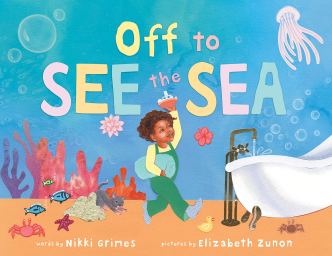 Off to See the Sea by Nikki Grimes, illustrated by Elizabeth Zunon
Off to See the Sea by Nikki Grimes, illustrated by Elizabeth Zunon
This imaginative bathtime picture book comes from the same author and illustrator who gave us Bedtime for Sweet Creatures last year and seems to feature the same protagonists. As the mother gives her child a bath, the third-person narrative voice describes the experience as an aquatic adventure. The running faucet is depicted as a waterfall, the bath itself is a sea, and the yellow rubber ducky is a monster. The toy tugboats, of course, become real boats, and the wet bathroom floor is the “distant shore”. Zunon’s illustrations are colorful multi-media collages with realistic human faces, which will be visually appealing for all ages toddlers and up. Between the imagination-based theme and the normal, everyday setting, this book will likely become a favorite frequent read-aloud for many families.
 Eyes That Kiss in the Corners by Joanna Ho, illustrated by Dung Ho
Eyes That Kiss in the Corners by Joanna Ho, illustrated by Dung Ho
The main character in this picture book is aware that her eyes look different than those of her friends, but she doesn’t mind. She’s proud to have eyes that “kiss in the corners and glow like warm tea,” just like her beloved mother, grandmother, and younger sister. This shared facial feature reminds her of her cultural heritage; the illustrations include images from Chinese folklore. The digital artwork features bright colors, particularly yellow, and emphasizes the intricate beauty of flowers, butterflies, and feathers. Due to the amount of text and the poetic, abstract tone, I would recommend this book for readers in early elementary school rather than preschoolers. I also think it’s worth acknowledging that, as some online reviewers have pointed out, this book may not be as affirming for adopted or biracial Asian American readers whose facial features don’t necessarily match those of their parents. Overall, though, the artwork and the beautiful portrayal of Chinese American culture make this book a worthwhile read.
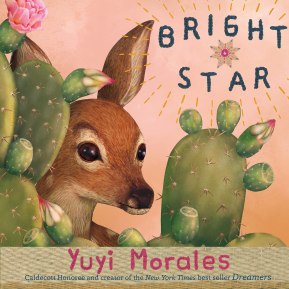 Bright Star by Yuyi Morales
Bright Star by Yuyi Morales
Set in the desert borderlands between the United States and Mexico, this book beautifully depicts the flora and fauna of the region. The story follows a mother whitetail deer and her fawn as they navigate the dangers of their native habitat. Nature-lovers in particular will find the illustrations fascinating regardless of whether they’re familiar with the wildlife of the Southwest. Narrated by the mother deer, the text is full of affectionate, feel-good passages, mostly in English but including some Spanish words. This book also obliquely addresses social and political issues related to immigration that will likely go over the heads of preschool-aged readers, but may serve as interesting conversation starters with older readers.
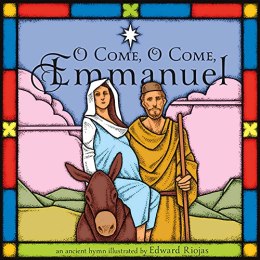 O Come, O Come, Emmanuel illustrated by Edward Riojas
O Come, O Come, Emmanuel illustrated by Edward Riojas
I promise I didn’t accidentally leave out the author’s name; the text of this book is the words of the familiar Advent hymn O Come, O Come, Emmanuel, which is based on an even older set of antiphons that probably date back to the sixth century AD. If there was a single original author, that person’s name is lost to history. But Riojas’s stained-glass-style illustrations are new and the resulting book is beautiful. The images include not only aspects of the nativity but also other religious artwork including a crucifixion scene and an image of Jesus fighting a dragon, that is, Satan. This is a great book for Christian parents to use to teach their children about the significance of the Advent season. It’s worth noting that this book comes in either English or Latin. I’m referring to the English version for this list, but my family purchased both and I would recommend either one.
 The Midnight Fair by Gideon Sterer, illustrated by Maricharia Di Gorgio
The Midnight Fair by Gideon Sterer, illustrated by Maricharia Di Gorgio
Vaguely reminiscent of the 1994 book Good Night, Gorilla, this wordless picture book depicts a variety of forest animals sneaking into a fair and enjoying the rides and carnival games at night after all the humans have left. But unlike the cartoonish artistic style of Good Night, Gorilla, which is best suited for preschoolers or even toddlers, The Midnight Fair is illustrated in a more mature technique with lots of details, shifts in perspective, and an evocative color palette that emphasizes the contrast between the dark blues and grays of the nighttime surrounding and the bright garish yellow light of the fair. Readers of a variety of ages will enjoy this book and will likely discover new details every time they read it.
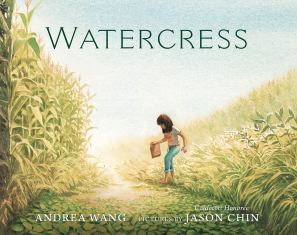 Watercress by Andrea Yang, illustrated by Jason Chin
Watercress by Andrea Yang, illustrated by Jason Chin
A Chinese-American family is driving through Ohio farmland when they stop to gather watercress, a green leafy vegetable related to kale. The younger sister is embarrassed to be picking plants from a roadside ditch and is loathe to eat the watercress back at home that evening. But then she learns that her uncle starved to death as a child, which gives her a new perspective on food, gratitude, and watercress itself. This is an example of a picture book that’s actually best suited for big kids rather than preschoolers and kindergarteners. For what it’s worth, the publishers and most reviews recommended this for a younger audience than what makes sense to me. But in my opinion, the subject matter, the nostalgic tone, the artistic style, and the necessary background knowledge all point towards a target audience of about third and fourth grade despite the picture book format and relatively sparse text.
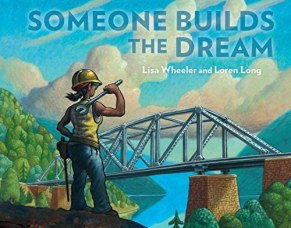 Someone Builds the Dream by Lisa Wheeler, illustrated by Loren Long
Someone Builds the Dream by Lisa Wheeler, illustrated by Loren Long
We all know that architects, engineers, and artists are important, but a big building project requires more than one talented professional. This cheerfully colorful picture book acknowledges the various types of work necessary to build a variety of projects including a house, wind power plant, themed roller coaster, and a book. Referring to the finished project as the “dream” gives this book a positive and motivational tone. I feel that the big-picture perspective of the illustrations and the emphasis on blues and greens also contribute to the uplifting nature of this story. The rhyming text and relative brevity make this book a great read-aloud whether at home, in a library storytime, or in the classroom. I can see using it with preschoolers or with elementary-school-aged kids. Highly recommended for kids who like construction-themed picture books or who enjoy reading about different jobs and careers.
Other Picture Books:
The Fabulous Tale of Fish & Chips by Helaine Becker, illustrated by Omar Hoffman
Milo Imagines the World by Matt de le Pena, illustrated by Christian Robinson
Christina’s Carol: Featuring the Classic Christmas Carol “In the Bleak Midwinter” by Christina Rossetti illustrated by Tomie DePaola
The Froggies Do NOT Want to Sleep by Adam Gustavson
Flip Flap Find: Into the Woods by Dawn Sirett
The Ramble Shamble Children by Christina Soontornvat, illustrated by Lauren Castillo
Mel Fell by Corey R. Tabor
Readers
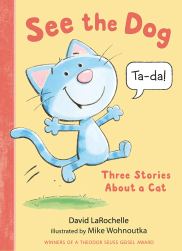 See the Dog: Three Stories About a Cat by David LaRochelle, illustrated by Mike Wohnoutka
See the Dog: Three Stories About a Cat by David LaRochelle, illustrated by Mike Wohnoutka
Let’s face it, sometimes early readers can be a little boring, especially at that very earliest reading level. There’s only so much plot you can fit into a short book with no more than four or five words per sentence and no more than one or two syllables per word. And although quite a few recent children’s authors have gotten really good at understanding juvenile humor, the fact of the matter is that the intrinsically funny word “underpants” is too big for most kindergartners to read and that limits authors in their ability to write hilarious content for beginning readers. Fortunately, LaRochelle has hit upon another concept that is objectively funny for virtually the entire target audience, and that concept is words that misalign with the pictures. This particular book is a companion to the 2020 book See the Cat: Three Stories About a Dog and both books center around the simple but effective joke of one animal taking another’s place. The main text gets it wrong, but word bubbles allow the characters to communicate directly with the reader.
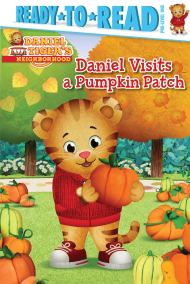 Daniel Visits a Pumpkin Patch by Maggie Testa, illustrated by Jason Fruchter
Daniel Visits a Pumpkin Patch by Maggie Testa, illustrated by Jason Fruchter
Okay, I’ll admit it, the reason that a book based on a PBS show is making it onto my list is because I only read a few beginning readers this year. Despite their popularity, I tend not to ascribe much literary value to children’s book series that are just part of a franchise based around a TV show. But I still ended up feeling that, of the early readers I did read this year, this Daniel Tiger book was the second best. It’s great for its target audience of kindergarteners (maybe slightly older or younger depending upon reading level) who are just starting to move beyond single-syllable words and short sentences. Thanks to colorful, full-page illustrations, lots of repetition, and questions directed to the reader, it feels easier than it really is and has the capacity to help young readers build their reading comprehension skills. The seasonal subject matter is also an appeal factor.
Chapter Books
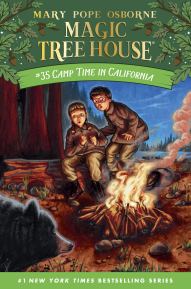 Camp Time in California by Mary Pope Osbourne, illustrated by A.G. Ford
Camp Time in California by Mary Pope Osbourne, illustrated by A.G. Ford
In this newest title in the popular Magic Tree House series, Jack and Annie go to Yosemite around the turn of the twentieth century, where they meet explorers named Teddy and John. Teddy turns out to be President Theodore Roosevelt, and John is naturalist John Muir, who guided Roosevelt on a tour through the area to persuade him to expand federal protection for the national park. While this book does a thorough job of describing the natural beauty of Yosemite and the value of conservation, I felt that the plot didn’t quite live up to the stellar precedent of most of the other books in the series. However, I still would recommend the entire series to readers in the 2nd-4th grade range and it still was one of my favorite couple books at that reading level of this past calendar year.
 Stuntboy, in the Meantime by Jason Reynolds, illustrated by Raul the Third
Stuntboy, in the Meantime by Jason Reynolds, illustrated by Raul the Third
At 272 pages, this one is much longer than most books I would categorize as “chapter books”, but it has lots of pictures and large font and I’d say the reading level is approximately third-grade. It tells the story of Portico Reeves and his superhero alter ego Stuntboy, whose superpower is “keeping other superheroes safe, so they can save the world!” Portico lives in a castle (or apartment building if that’s the term you prefer) called Skylight Gardens with his parents, his Gran Gran, and a cat called A New Name Every Day. His best friend Zola and his supervillain enemy Herbert Singletary the Worst also live at Skylight Gardens. Portico acknowledges that his superhero identity is his way of coping with his anxiety, but this system stops working so well when two of his favorite superheroes (his parents) are “in the mean time”. Under the circumstances, Portico misunderstands them and assumes that the phrase “mean time” refers to times when they’re arguing. Over the course of the book, Zola helps Portico cope with his parents’ problems by comparing incidents to episodes from their favorite superhero show.
 One Smart Sheep by Gary D. Schmidt and Elizabeth Stickney, illustrated by Jane Manning
One Smart Sheep by Gary D. Schmidt and Elizabeth Stickney, illustrated by Jane Manning
Abigail Atwood has twenty-six sheep in her pen at the top of Atwood Hill and Wilson is the friendliest, wooliest, and smartest. Unfortunately, he’s not quite smart enough to stay out of trouble. In an attempt to enter Abigail Atwood’s house, Wilson accidentally ends up inside a delivery truck that takes him to the city. Abigail must go in search of him with the help of her loyal border collie Tippy and her unpleasant neighbor Jeremiah Jefferson. The simple plot, short chapters, large font size, and colored illustrations make this book a great choice for reluctant readers in the second-grade through fourth-grade range because it feels easier than it is. (Alternatively, it would also be a good choice for younger, newly independent readers who are up for a challenge as long as there are pictures involved) One Smart Sheep is a pretty quick read, yet it contains quite a few big words and has some long, complex sentences, putting it at around a third grade reading level.
Graphic Novels
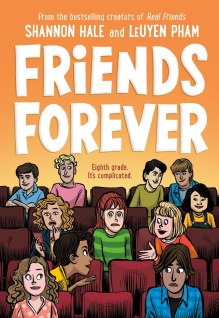 Friends Forever by Shannon Hale and LeUyen Pham
Friends Forever by Shannon Hale and LeUyen Pham
This is the third book in a series of autobiographical graphic novels in which Shannon Hale recounts challenges from her childhood and preteen years. The first two books, Real Friends from 2017 and Best Friends from 2019, put a lot of emphasis on Shannon’s social life, hence the use of the word “friends” in each title, but this newest addition to the series puts a somewhat greater focus on Shannon’s personal sense of identity. Now in the eighth grade, Shannon struggles with perfectionism and is constantly looking for ways to improve herself. She wants to be prettier, to gain recognition for her skills as a performer and a writer, and to be a perfect Christian. Over the course of the book, Shannon tries her best to excel in various aspects of her life and is discouraged by each minor failure. In a somewhat abrupt and anticlimactic ending, she pulls herself out of her anxiety and depression despite an unhelpful psychiatrist who tells her she’s a “normal teen with normal teen problems”. The color palette varies depending upon Shannon’s state of mind, a clever touch that demonstrates the literary value of the graphic novel format for this type of narrative.
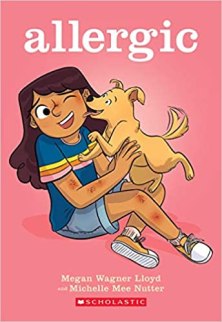 Allergic by Megan Wagner Lloyd and Michelle Mee Nutter
Allergic by Megan Wagner Lloyd and Michelle Mee Nutter
On her tenth birthday, after years of “waiting and wishing and hoping and begging,” Maggie is finally going to get a dog. But as soon as she meets her prospective puppy, she discovers that she’s allergic. A doctor’s visit and allergy test confirm it: Maggie has severe allergies that rule out the possibility of a dog or other pet with fur or feathers. The disappointing news is made even worse by the other changes going on in Maggie’s life. She has to switch schools due to a change in the school district boundaries, and her family is expecting a new baby. Maggie already feels like the odd sibling out because her younger brothers are twins, and now she feels like the baby is taking up all of her parents’ attention. Fortunately, Maggie does befriend a new girl named Claire, who initially seems like the perfect best friend, but then Claire gets a puppy and Maggie feels betrayed. Later, Claire helps Maggie buy a secret pet mouse, which triggers her allergies, especially after the mouse has babies. Everything comes to a head when Maggie’s family finds out about the mice immediately before the (human) baby is born. This realistic middle-grade graphic novel will appeal to fans of Raina Telgemeier, Victoria Jamieson, and Shannon Hale.
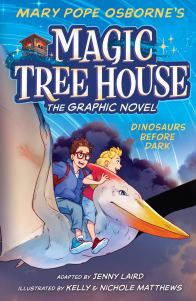 Magic Tree House: Dinosaurs Before Dark adapted by Jenny Laird, illustrated by Kelly & Nichole Matthews
Magic Tree House: Dinosaurs Before Dark adapted by Jenny Laird, illustrated by Kelly & Nichole Matthews
Mary Pope Osbourne’s popular chapter book series is now being adapted into graphic novel format, and this first title in the series is promising and pleasingly true to the original. For what it’s worth, the second book is already out but I haven’t read it yet. In this story, eight- (and a half) year old Jack and his younger sister Annie discover a mysterious tree house in the woods near their home in Frog Creek, Pennsylvania. Despite Jack’s reservations, when he realizes that the tree house is full of books, he can’t resist taking a look around. Jack looks at a book about dinosaurs and comments that he wishes they could go “there”, that is, to the time of the dinosaurs. That’s when he and Annie discover that the tree house is magical and can take them to the places depicted in the books. This graphic novel adaptation is almost word-for-word identical to the chapter book version, although I felt that it’s geared for a slightly older audience and gives a more mature take on the differences between Jack’s cautious, practical personality and Annie’s spontaneous, happy-go-lucky attitude.
Middle Grade Novels
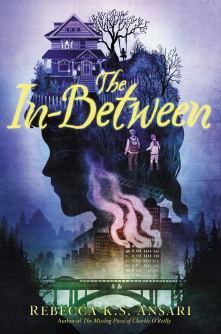 The In-Between by Rebecca K.S. Ansari
The In-Between by Rebecca K.S. Ansari
In this spooky speculative novel, thirteen-year-old Cooper Stewart and his younger sister Jess realize that their mysterious new neighbor seems to have some connection to a century-old mystery involving a train crash. After Cooper tries to investigate by talking to the neighbor girl, he and Jess and a new friend named Gus find themselves in the midst of a complicated supernatural mystery. Be forewarned that if you read my full review linked above, you will encounter spoilers about a couple of the twists and turns in this complex plot. Side plots include Jess’s diabetes and Cooper’s emotional struggles related to his parents’ divorce. In addition to the intriguing plot, this book ends up also being a feel-good story about sibling relationships, the value of holding onto memories, and the importance of human connection.
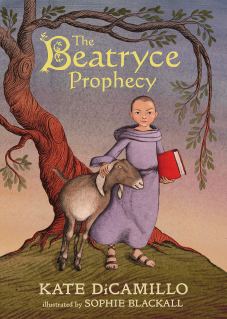 The Beatryce Prophecy by Kate DiCamillo, illustrated by Sophie Blackall
The Beatryce Prophecy by Kate DiCamillo, illustrated by Sophie Blackall
When Brother Edik, a monk of the Chronicles of Sorrowing, discovers a girl curled up with the “demon goat” Answelica, she can’t tell him anything about who she is or where she came from besides her name, Beatryce. But she knows how to read and write, and that means she’s someone special and she’s probably in trouble. In fact, Brother Edik is pretty sure that one of his early prophecies is about her and that she’s destined to unseat the king. The monks send her away, along with Answelica, and she makes a group of friends in an orphaned boy named Jack Dory, a strange man who lives in the woods and no longer has a name, and Brother Edik, who eventually comes after her. The Beatryce Prophecy combines elements of medieval historical fiction, fantasy, and adventure (with some comic relief, mostly thanks to Answelica) to tell a story that will appeal to fans of any of those genres as well as any readers who have enjoyed DiCamillo’s other books. Her characteristic writing style is clear throughout this book in the simple, straightforward dialogue but nuanced imagery, repetition of specific words and phrases, and emphatic themes including the friendship, storytelling, the value of literacy, and the power of names. Highly recommended for most middle grade readers, many teens and adults, and families looking for a good all-ages book to enjoy together.
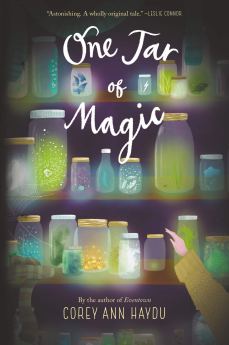 One Jar of Magic by Corey Ann Haydu
One Jar of Magic by Corey Ann Haydu
Rose Alice Anders and her family live in a magical realism setting where everyone over the age of twelve spends New Year’s Day at the lake catching magic. Rose’s father is famous for his prolific magic-catching abilities, so Rose has always been told that she is destined for greatness. Everyone expects her to break records on her first try at collecting magic. But when the time comes, Rose surprises and disappoints everyone by only catching one jar of magic. This sets off an identity crisis in which Rose wonders if she’s “Not Meant for Magic”, and whether magic is really as important as she’s always been told. The narrative is interspersed with flashbacks that gradually reveal just how manipulative and abusive Rose’s father is. The atmospheric and fantastical setting is juxtaposed against very realistic but problematic family dynamics in which unrealistic expectations, conditional love, and an obsession with reputation have forced a family to turn their shortcomings into dark secrets.
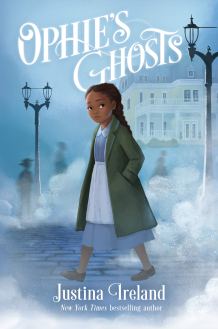 Ophie’s Ghosts by Justina Ireland
Ophie’s Ghosts by Justina Ireland
It’s 1922 and twelve-year-old Ophelia Harrison (otherwise known as Ophie) has just lost her father in a lynching. Since this traumatic event, Ophie has begun seeing ghosts. She and her mother move to Pittsburgh and start working as servants for rich, grumpy Mrs. Caruthers and her son Richard. Ophie quickly befriends Clara, a beautiful and sophisticated ghost who had been the previous maid. Ophie’s great aunt Rose warns her that ghosts are dangerous and that she shouldn’t interact with them, but Ophie has decided that it’s her responsibility to help ghosts pass on. She especially wants to help Clara, not only because of their bond, but also because she realizes that Clara has been murdered due to a forbidden romance. But she underestimates just how powerful and dangerous Clara really is. Although this book is somewhat less scary than some middle-grade ghost stories, such as those by Mary Downing Hahn and Dan Poblocki, it will have a strong appeal for any middle-grade readers with an affinity for suspenseful, spooky stories. Other appeal factors include the vivid, atmospheric description of the historical Pittsburgh setting, the focus on African American history, and Ophelia’s likable personality. Recommended for most readers within the middle-grade age range and all fans of the historical ghost story sub-genre.
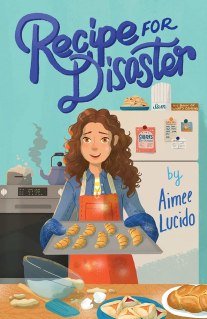 Recipe for Disaster by Aimee Lucido
Recipe for Disaster by Aimee Lucido
Twelve-year-old Hannah Malfa-Adler is tired of being told that she isn’t really Jewish. After her best friend Shira’s bat mitzvah, Hannah decides that she’s going to have her own bat mitzvah. Her parents say no, but with the help of her Grandma Mimi and her estranged Aunt Yael, Hannah begins studying Hebrew and preparing for her bat mitzvah. In the meantime, Hannah’s sudden interest in her Jewish heritage has caused tension within her family and also with Shira, who thinks that Hannah is lying about the bat mitzvah. As her friendship with Shira deteriorates, Hannah befriends a new girl, Vee, but she later damages that new relationship by insinuating that Vee isn’t “really Jewish”. When sudden tragedy strikes Hannah’s family, it forces her to change her plans for her bat mitzvah, but it also provides the catalyst for Hannah to repair several different relationships. Although this book is mostly in prose, it includes sections in verse, and all of this is interspersed with recipes. Although the plotline consists mostly of common middle grade topics, the baking motif gives it a memorable and meaningful twist.
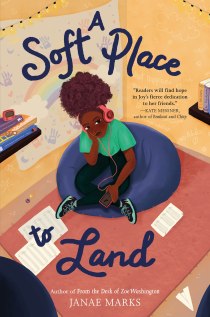 A Soft Place to Land by Janae Marks
A Soft Place to Land by Janae Marks
Twelve-year-old Joy Taylor feels as if she’s lost everything. Since her father lost his job, her family had to sell their house and move into a small apartment where she has to share a room with her little sister, and she can’t get the piano that she needs in order to work towards her dream of becoming a film score composer. Then a neighbor girl named Nora lets her in on a secret: The kids in the building have a secret Hideout where they have regular game nights and where they can go anytime they need privacy. Nora also helps Joy start a dog-walking business, which Joy hopes will make it possible for her to buy a piano and pay for her own piano lessons after all. Then Joy makes a terrible mistake and accidentally spends a night in the Hideout. When her mother comes looking for her, she discovers the Hideout, and the kids are no longer allowed to hang out down there. All of the kids are furious except for Nora, and even Nora gets in a fight with Joy later. The next day, Nora doesn’t show up to help Joy walk dogs, and Joy drops a leash and loses a dog. In the final chapters of the book, Joy must find the missing dog, repair all of her damaged friendships, and find some way to replace the Hideout. Thanks to its believable characters, emotional and introspective writing style, and themes of secrecy and escape, this book will appeal to a wide audience.
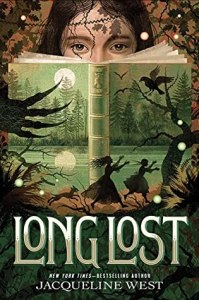 Long Lost by Jacqueline West
Long Lost by Jacqueline West
Eleven-year-old Fiona Crane is upset that her family has moved to the town of Lost Lake just to be closer to the figure skating club where her older sister Arden trains, but she takes solace in the local library. There she finds an intriguing green book which she gradually realizes is the true story behind a mysterious piece of local history. But when the book disappears, the librarian tells Fiona that it was never in the collection. After Fiona finally finds it, she’s disappointed to find that the story ends abruptly with lots of blank pages at the end. Later, those pages fill up with the true ending of the story. Although Long Lost is technically a ghost story, the ghosts in this novel show up late enough that it feels more like a realistic fiction book about sisterhood than a horror story. The strained relationship between Fiona and Arden ends up playing an important role in the plot. Long Lost is also a tribute to libraries which glorifies research and local history. Within this context, Fiona’s bookish interests aren’t so cliche for a middle grade heroine, but rather, they are integral to the plot. Despite the fact that Long Lost puts less emphasis on its supernatural elements than other middle grade ghost stories do, it has a satisfyingly spooky mood that will appeal to the same target audience.
Other Middle Grade Novels
Amari and the Night Brothers by B.B. Alston
Thornwood by Leah Cypess
Unplugged by Gordon Korman
Clues to the Universe by Christina Li
The Mending Summer by Ali Standish
The Shape of Thunder by Jasmine Warga
The Verdigris Pawn by Alysa Wishingrad
Verse
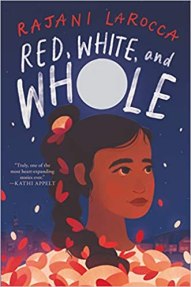 Red, White, and Whole by Rajani LaRocca
Red, White, and Whole by Rajani LaRocca
It’s 1983 and thirteen-year old Reha is an Indian American girl living in a predominantly white community. She sometimes struggles with the conflicts between the two cultures that have shaped her identity, but these problems seem insignificant when she finds out that her mother has leukemia. Chemotherapy doesn’t work, so Reha holds out hope that a bone marrow transplant will be the solution. The title contains a double meaning that has symbolic significance within the story. “Red and white” refers both to Reha’s two cultures and to blood cells, an important motif throughout the story because Reha’s mother is a phlebotomist as well as a patient with a blood-related illness. There are several passages in the book that compare and contrast the connotations of the two colors. The novel-in-verse format is fitting for the introspective, stream-of-consciousness nature of much of this book and for its emotional depth.
 The One Thing You’d Save by Linda Sue Park, illustrated by Robert Sae-Heng
The One Thing You’d Save by Linda Sue Park, illustrated by Robert Sae-Heng
In this brief illustrated novel in verse, a teacher challenges her students to decide what object they would save if their home was on fire. (She clarifies that we’re assuming that all family members and pets are already safe, and she reminds students that, in the case of a real fire, they shouldn’t actually go back for anything) Few of the students are mentioned by name, but they each get a turn to give their answer. Their discussion is insightful and their varied responses give readers an idea of the characters’ individual personalities and backstories. Park’s literary talent is clear in that she manages to achieve this while keeping the text so succinct. Some of the students want to save collectibles or mementos, and one student says they’d save their laptop because it’s expensive. Many talk about items that remind them of deceased family members or pets, and one student has actually experienced a home fire already. The format and style is based on sijo, a traditional Korean poetic form.
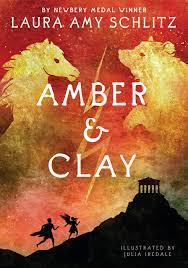 Amber and Clay by Laura Amy Schlitz
Amber and Clay by Laura Amy Schlitz
Rhaskos is a Thracian slave boy with a secret love for art and Melisto is the daughter of wealthy Athenians, loved by her father but despised by her mother. Based on the ancient Greek concept of what we modern folk might call “soulmates”, this book follows these two very different protagonists in their very different lives until one of them dies suddenly. Only after Melisto becomes a ghost do the two protagonists get to know each other. The passages about Rhaskos are written in verse while the passages about Melisto prior to her death are written in prose. There are also passages narrated by Hermes and interludes that describe objects from the story as artifacts. Although this book got several starred reviews, I’ve also seen it critiqued for being too difficult and erudite. While I certainly agree that this book will only appeal to a niche audience, I think that Greek mythology is popular enough (especially thanks to the Percy Jackson books) that this niche audience won’t be quite as small as some reviewers have assumed. With that being said, I disagree with the age level recommendations I’ve seen for this book; I definitely would consider it YA rather than middle grade.
YA Novels
 A Sitting in St. James by Rita Williams-Garcia
A Sitting in St. James by Rita Williams-Garcia
Set on an antebellum Louisiana plantation, this novel follows various members of the Guilbert family through an eventful few weeks of social life, schemes, and a forbidden romance. Madame Sylvie, the family matriarch, aims to flaunt her background as a member of pre-Revolution French aristocracy by throwing a party and commissioning a painting she can’t afford. Her son Lucien wants to elevate the social status of his illegitimate, mixed-race daughter Rosalie, and he seeks to arrange a marriage for her despite Madame Sylvie’s refusal to acknowledge Rosalie as a member of the family. Lucien’s son Byron is trying to please his grandmother by securing an engagement with a girl from a neighboring plantation despite the fact that he is in a homosexual romance. And Jane Chatham, a rebellious teenager who is staying with the Guilberts in order to take lessons in proper social behavior from Madame Sylvie, just wants to ride her horse. The various subplots involving the white protagonists are interspersed with the stories of their slaves, many of whom have suffered rape, beatings, and the sudden disappearance of family members. Despite the book’s somewhat one-dimensional characters, readers with an interest in the time period or the history of Louisiana will enjoy this novel and probably learn quite a bit from it. Comparing and contrasting this book with Gone with the Wind, while taking into account when each of these books was written and how they were researched, would make an interesting academic exercise for young adult readers.
 Instructions for Dancing by Nicola Yoon
Instructions for Dancing by Nicola Yoon
Seventeen-year-old Evie, formerly an avid romance reader, doesn’t believe in love any more since her parents’ divorce. After donating her collection of YA romances and picking up a little book on ballroom dancing, Evie starts seeing visions. Every time she witnesses a couple kissing, she sees a series of scenes from their relationship, from when they met until their inevitable painful breakup. At the advice of her friend Martin, Evie decides to investigate her visions by visiting the ballroom dance studio whose address is stamped on the book. Predictably, she gets roped into a class and then into signing up for a competition. Her partner is a stereotypical YA-novel hot guy named Xavier, X for short. They go on a few pseudo-dates to develop their chemistry and quickly decide to start dating for real. But while their idealistic relationship is developing, Evie’s disillusionment with romance is furthered by finding out that her father is getting remarried and by learning through her visions that two of her best friends, who are newly in love, are about to have a messy breakup that will dissolve her friend group.Then Evie sees a vision about her own relationship, informing her that it will end in tragedy. In the final pages of the book, she must re-evaluate her opinions on love and loss. This book is exemplary of its genre and will appeal to fans of emotional YA romances. Although it relies heavily on tropes and cliches, its humorous self-awareness keeps this from being a real flaw.
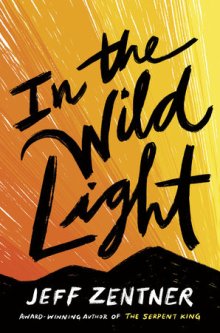 In the Wild Light by Jeff Zentner
In the Wild Light by Jeff Zentner
Cash Pruitt is a pretty ordinary Appalachian teenager, except for a tragic backstory involving his mother’s death, but his best friend Delaney Doyle is most decidedly not ordinary. After discovering a new strain of penicillin recently, she has started receiving the attention she deserves as a science prodigy and now she’s been offered a full tuition scholarship at a prestigious boarding school in Connecticut. The school is so eager to have Delaney that they also offer Cash a full tuition scholarship at her request. Cash is reluctant to go; he loves his quiet life in rural Tennessee and he doesn’t want to leave his grandparents, especially since his Papaw is terminally ill. But because Delaney and his grandparents all want him to, Cash eventually agrees and accompanies Delaney to Middleford Academy. Over the course of the school year, Cash makes several new friends and one enemy, discovers a love of poetry, experiences multiple heartbreaks, and learns a variety of life lessons. This is a beautifully emotional book full of complex characters, poignant introspection, and vividly nostalgic descriptions of east Tennessee.
Nonfiction
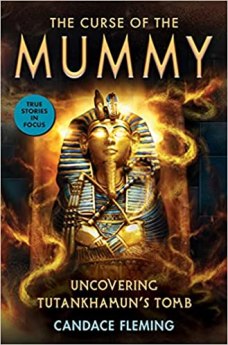 The Curse of the Mummy: Uncovering Tutankhamun’s Tomb by Candace Fleming
The Curse of the Mummy: Uncovering Tutankhamun’s Tomb by Candace Fleming
Like the other royal Egyptian tombs, Tutankhamun’s resting place was disrupted by tomb robbers shortly after his burial, but unlike the rest, the boy king’s tomb was never picked bare; its entrance was completely hidden after a rainstorm that left the valley full of mud and sediment. When archeologists found it thousands of years later, it was full of intact artifacts including the mummy of the pharaoh. But before the sarcophagus was even opened, Lord Carnarvon, the English nobleman who was financing the excavation, died suddenly of an infected mosquito bite. In subsequent years, several other egyptologists and VIPs who had visited the tomb also died strange deaths. And so rumors of a mummy’s curse swirled. Although most of this book focuses on the factual details of the dig, there are brief interludes between the chapters, printed on black paper and always starting with the phrase “it was said”, which present the ancient mummy’s curse as a plausible explanation. (Spoiler: In the final chapter, this theory is debunked, perhaps a little too quickly and dismissively to constitute a satisfying ending) Besides the discussion of the curse, this book also gives a lot of interesting contextual information about the discovery, including the history and policies of the Egyptian Antiquities Service and Howard Carter’s backstory. Aspiring archeologists and Egyptologists will love every page of this book. Recommended for tweens, teens, and adults.
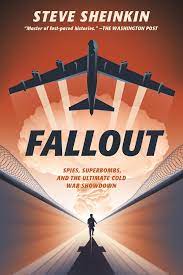 Fallout: Spies, Superbombs, and the Ultimate Cold War Showdown by Steve Sheinkin
Fallout: Spies, Superbombs, and the Ultimate Cold War Showdown by Steve Sheinkin
From the author of the award-winning 2012 book Bomb, this newer book covers similar topics and has the same fast-paced, narrative writing style, almost sounding like fiction but with a wider cast of characters. While Bomb focused mainly on scientists and technology, Fallout features spies and politicians. Bomb took place during World War II, although the events it describes led directly to the Cold War, but Fallout is entirely about the Cold War, specifically focusing on the Cuban Missile Crisis and the events that led to it. Given the book’s teenage target audience, it does an excellent job of covering the complicated political situation in great detail. In fact, despite the fact that I went through a phase when I read everything I could find that mentioned President Kennedy, this book is probably the most thorough description of the Cuban Missile Crisis that I’ve ever read. I highly recommend this book for teenagers and adults alike, including those who don’t normally enjoy nonfiction or war stories. Sheinkin’s writing is so engaging that I’m sure somewhere out there, there will be some readers who will discover that they’re more interested in the topic than they would have guessed.
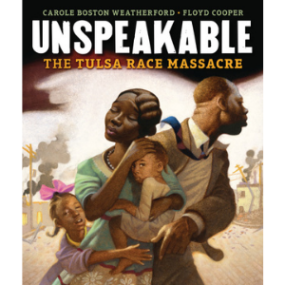 Unspeakable: The Tulsa Race Massacre by Carole Boston Weatherford, illustrated by Floyd Cooper
Unspeakable: The Tulsa Race Massacre by Carole Boston Weatherford, illustrated by Floyd Cooper
As the title implies, this nonfiction picture book tells the story of the Tulsa Race Massacre of 1921. Prior to that time, the Greenwood district of Tulsa, Oklahoma, was a thriving African American community with some of the most successful Black-owned businesses in the country. But after a false accusation against a Black teenager, mob violence resulted in destruction and an unknown number of casualties. Although discussions of historical events like this require quite a bit of background information for context, this book does a surprisingly good job of telling the story so simply and succinctly that even readers as young as second or third grade can understand.The detailed oil-painted illustrations, most of which focus on human faces and human emotion, will likely help to make this book and its subject matter memorable for readers.
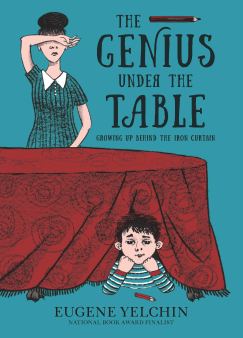 The Genius Under the Table: Growing Up Behind the Iron Curtain by Eugene Yelchin
The Genius Under the Table: Growing Up Behind the Iron Curtain by Eugene Yelchin
Award-winning author and illustrator Eugene Yelchin, perhaps best known for his 2011 middle grade novel Breaking Stalin’s Nose, has turned to memoir in this book about his own experience as a child in Soviet Russia. He describes a life of financial hardships and scarcity, of censorship and artistic repression, of fear and uncertainty. Much of the plot is driven by the question of what talent young Yelchin might be able to develop in order to earn the freedoms that are only allowed to famous people in Soviet Russia, yet he also learns over the course of the book that even artists, performers, and poets must choose between risking death or learning to “follow the rules” of an oppressive government. The title alludes to the moment when Yelchin’s father discovers his son’s artistic talent in drawings on the underside of his grandmother’s table. Despite the weighty themes this book discusses and the hardships it describes, the overall tone is light and at times even comical. The frequent illustrations and the middle-grade reading level make this book pretty quick and easy read. The first couple chapters do include a little contextual information about the Cold War and Russia, so I personally feel that kids as young as fourth or fifth grade can probably understand most of it.
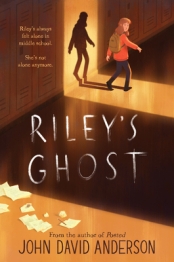 Riley’s Ghost by John David Anderson, 2022
Riley’s Ghost by John David Anderson, 2022 Off to See the Sea
Off to See the Sea  Eyes That Kiss in the Corners
Eyes That Kiss in the Corners  Bright Star
Bright Star  O Come, O Come, Emmanuel
O Come, O Come, Emmanuel  The Midnight Fair
The Midnight Fair  Watercress
Watercress  Someone Builds the Dream
Someone Builds the Dream  See the Dog: Three Stories About a Cat
See the Dog: Three Stories About a Cat  Daniel Visits a Pumpkin Patch
Daniel Visits a Pumpkin Patch  Camp Time in California
Camp Time in California  Stuntboy, in the Meantime
Stuntboy, in the Meantime  One Smart Sheep
One Smart Sheep  Friends Forever
Friends Forever  Allergic
Allergic  Magic Tree House: Dinosaurs Before Dark
Magic Tree House: Dinosaurs Before Dark The In-Between
The In-Between The Beatryce Prophecy
The Beatryce Prophecy  One Jar of Magic
One Jar of Magic  Ophie’s Ghosts
Ophie’s Ghosts  Recipe for Disaster
Recipe for Disaster  A Soft Place to Land
A Soft Place to Land  Long Lost
Long Lost  Red, White, and Whole
Red, White, and Whole  The One Thing You’d Save
The One Thing You’d Save Amber and Clay
Amber and Clay  A Sitting in St. James
A Sitting in St. James  Instructions for Dancing
Instructions for Dancing  In the Wild Light
In the Wild Light  The Curse of the Mummy: Uncovering Tutankhamun’s Tomb
The Curse of the Mummy: Uncovering Tutankhamun’s Tomb Fallout: Spies, Superbombs, and the Ultimate Cold War Showdown
Fallout: Spies, Superbombs, and the Ultimate Cold War Showdown  Unspeakable: The Tulsa Race Massacre
Unspeakable: The Tulsa Race Massacre  The Genius Under the Table: Growing Up Behind the Iron Curtain
The Genius Under the Table: Growing Up Behind the Iron Curtain